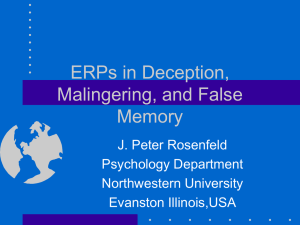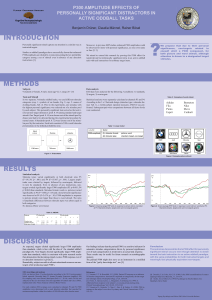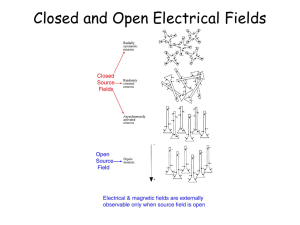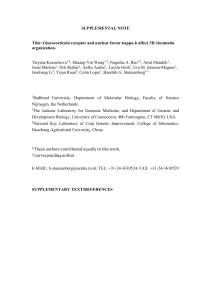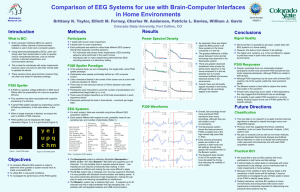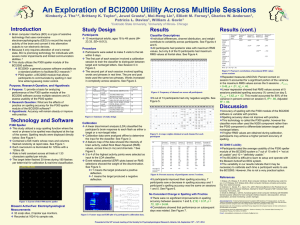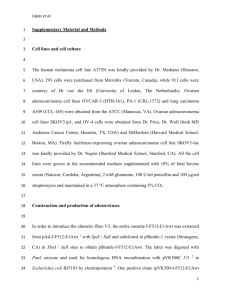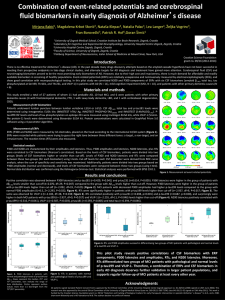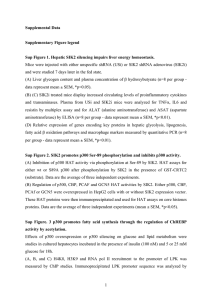321-2015 - Northwestern University
advertisement
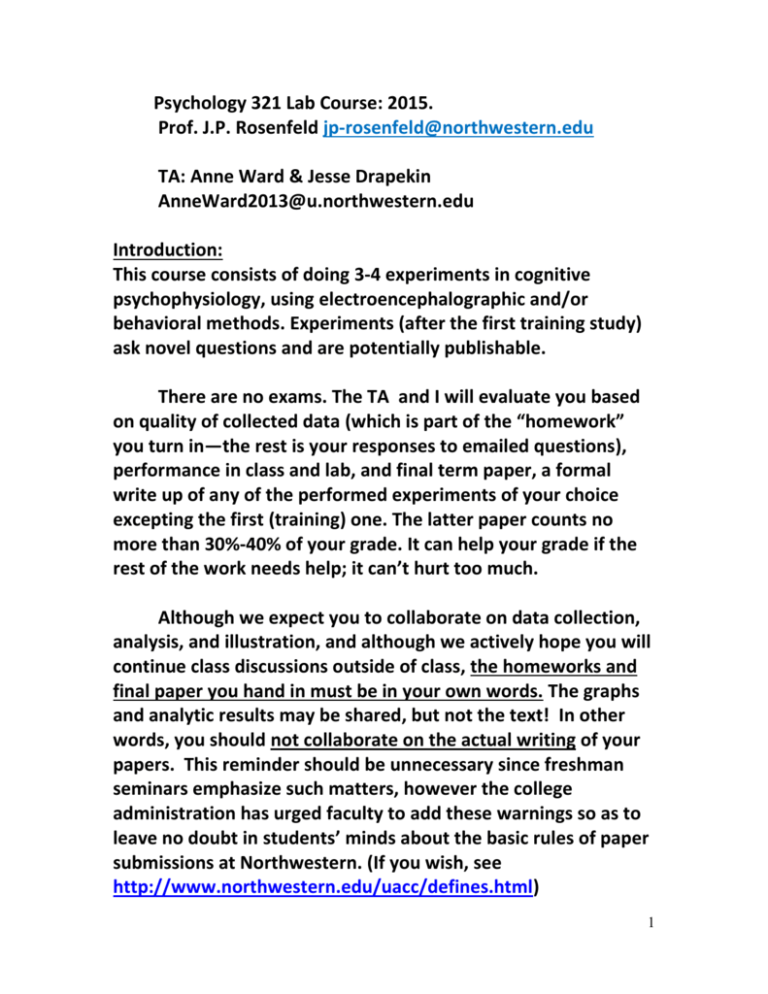
Psychology 321 Lab Course: 2015. Prof. J.P. Rosenfeld jp-rosenfeld@northwestern.edu TA: Anne Ward & Jesse Drapekin AnneWard2013@u.northwestern.edu Introduction: This course consists of doing 3-4 experiments in cognitive psychophysiology, using electroencephalographic and/or behavioral methods. Experiments (after the first training study) ask novel questions and are potentially publishable. There are no exams. The TA and I will evaluate you based on quality of collected data (which is part of the “homework” you turn in—the rest is your responses to emailed questions), performance in class and lab, and final term paper, a formal write up of any of the performed experiments of your choice excepting the first (training) one. The latter paper counts no more than 30%-40% of your grade. It can help your grade if the rest of the work needs help; it can’t hurt too much. Although we expect you to collaborate on data collection, analysis, and illustration, and although we actively hope you will continue class discussions outside of class, the homeworks and final paper you hand in must be in your own words. The graphs and analytic results may be shared, but not the text! In other words, you should not collaborate on the actual writing of your papers. This reminder should be unnecessary since freshman seminars emphasize such matters, however the college administration has urged faculty to add these warnings so as to leave no doubt in students’ minds about the basic rules of paper submissions at Northwestern. (If you wish, see http://www.northwestern.edu/uacc/defines.html) 1 Many students have taken 312-1 and 312-2. All should have read the first 8 chapter’s of Andreassi’s Psychophysiology, most recent 5th edition, Read as much as you need to read if you lack 312-1,2. (If you took 312-2, you should have read this material). It is also extremely useful and required background to read : Rosenfeld (2011), P300 in Detecting Concealed Information. In B. Verschuere, G. Ben Shakhar, & E. Meijer, (Eds.) Memory Detection: Theory and application of the concealed information test . Cambridge University Press. 63-89. Here’s a link to the manuscript: P300 in Detecting Concealed Information (in B. Verschuere, G. Ben Shakhar, & E. Meijer, (Eds.) Memory Detection: Theory and application of the concealed information test, in press, 2010). Note, I will refer to this below as “Rosenfeld, (2011)” even though the date in the link is 2010, which is when the manuscript was finalized. I will often refer to papers on our web page. To get there, google “J Peter Rosenfeld” and most papers are on publications link. Some are under specific course links, usually, 312-2. Check emails daily for assignments and readings. Readings can be challenging as they are from the primary literature. They are essential if you really want to get something out of this class. We will answer any and all questions you raise about them. Other readings will be handed out, or much more often, found on my web site, or elsewhere on line or in this outline. 2 The papers you read comprise the background of the experiments you perform. We are usually ourselves as subjects in these studies. (Do not wear contact lenses as subjects. Wear glasses. Contacts make you blink, which messes up EEG recording.) You can’t, therefore, be too naïve, but if naivety is necessary, we will mislead you as necessary! Sometimes you may bring in 1 or 2 friends to run. An outline follows. It is important that you to try and answer the interspersed homework questions (given in this blue font) in this experimental outline before the class in which we will discuss things. It is required that the homeworks be collected. They will receive the grade of OK, OK+ or OK-. Please keep answers brief. One or two doubled spaced pages per homework is usually sufficient. I prefer to read “I don’t know” than a page full of---silly stuff (to put it politely). Computer printed homework only. In this outline, the homework questions will be in color and/or otherwise emphasized in special font, so you can’t miss them. You must re-type the question above each answer. Outline: Introduction The first experiment (outlined below) is designed to get you up to speed on using our lab software for data collection, as well as on electrophysiological methods such as electrode application. It also affords you an opportunity to demonstrate the more or less 3 classic P300 or P3b event-related potential or ERP, which we will be using in later experiments. (If you feel lost already, have a look at those chapters in Andreassi and Rosenfeld (2011: link above), or you soon really will be lost.) We have some homebrewed lab manuals we wrote for you as guides to software and hardware. In a nutshell, if a subject is seated in front of a display screen and a repeating random series of various names appears for a half second every 3-4 seconds, each time his/her own name appears (about 10-20% of the presentations), the EEG will show a “Tsunami” series of larger wave peaks and troughs which tower over the background EEG. The P300 appears in response to relatively rare, meaningful stimuli. This happens if the recording electrode is attached to the appropriate scalp site overlaying appropriate cortex. If the electrode is pasted to the scalp, as it is for 99% of human EEG work, the Tsunami may be hard to see, since it is now far from the source(s) of voltage and may get buried in the ongoing background EEG. However if one averages many—like 30—responses to one’s own name and then superimposes this averaged ERP (AERP) on top of the averaged responses to the other, meaningless names, one will see the P300 easily, as indicated below with the thick vertical lines at 3 scalp locations, Fz, Cz, and Pz. 4 P300 is so called because it is a positive-going wave (yes, we plot positivity as down-going with some good reasons) which follows the stimulus by 300-800 ms. The stimulus occurs near the beginning of the sweeps above, and may be seen above ( at Fz, for example) at left where the ERP lines stop being flat. “EOG” refers to electro-occulogram, which we simultaneously record from above and below the eye. This EOG trace shows eye movement activity and should be flat, as our software removes trials with eye movement artifacts that are so big as to obscure the brain waves if we let them pass. Lately, we have also used another method of controlling EOG artifact: The software generates a f(EOG) which is subtracted from the EEG records. Of course we assume attention is paid to the stimuli here, or no P300 will appear. Sometimes (as in Exp. 1 below), we guarantee this by requiring a unique response to certain defined “ target” stimuli that appear occasionally, unexpectedly, randomly. As the subject is alert for targets, he must therefore see the other stimuli, since targets and other stimuli appear in a 5 random order. Another method of forcing attention is that we give a subject 5-6 pop-quizzes every so often in which we see if the subject can tell us what stimulus was just presented (after it is cleared from the display). The subject is warned in advance that dire consequences will follow if he fails more than one such pop quiz. Anyway, in our first experiment, there will be a series of letter strings (either XXXXX or OOOOO) presented, one of which, presented 20% of the time will be defined as a target string. After the data are collected, the WINEEG software program averages the ERPs for you into separate target and non-target ERP averages for each subject. Our analysis program “MSEGX8” is used to calculate P300 amplitude and latency for each subject, for each stimulus type. This will be described in class, & below. You then enter the data into our group statistics programs (SYSTAT) and do the appropriate tests. ALWAYS READ THE EXPERIMENTAL OUTLINE BEFORE THE CLASS AND ABSOLUTELY BEFORE YOU GO TO THE LAB TO DO THE EXPERIMENT!!!!! Experiment 1. “XNO “ This is a very simple study designed to teach you to use some of the basic software that collects and analyzes data, as well as the basic techniques of applying electrodes to the scalp. It is also 6 designed to allow you to demonstrate for yourself that the P300 ERP is readily obtained with rare and meaningful stimuli. You will have a stimulus set consisting of the letter strings “ XXXXX” and “OOOOO” (hereafter abbreviated, X and O). You will press a NO button for the frequent Os and a YES button for the rare target Xs. The rare (probability = 0.2), meaningful oddballs should evoke the larger P300. The ITI will be 3 sec. Press the button asap after the stimulus. HOMEWORK 1-1: a) What is the probability of the O stimulus? b) The targets are rare, but what makes the targets meaningful? Remember You must re-type the question above each answer. HOMEWORK 1-2: Bring in your average ERPs printed out, the targets superimposed on the frequents. I will lecture on how our software (“WINEEG” and “PSYTASK”, from MITSAR Corp., in Russia) and Bootstrap generate stimuli, critical time intervals, analyzes results, etc. You will collect the average ERPs on yourselves, recording from Fz, Cz, Pz, and EOG monitoring electrodes. Our software creates separate average ERPs in response to Xs and Os. You will run our MATLAB-based “MSEGX8” software which calculates P300 latencies and amplitudes. You will also 7 run Bootstrap to compare the abilities of various numbers of sweep samples (see below) to discriminate X and O P300 amplitudes. You will enter the MSEGX values into the SYSTAT (a Windows program) worksheet for analysis I will discuss in class. Be sure you are up on Andreassi chapters 1-8 and that Rosenfeld (2011) chapter noted above with a provided link. ______________________________________________________ 8 Experiment 2: We recently published this paper in Psychological Science: “Suppressing Unwanted Autobiographical Memories Reduces Their Automatic Influences: Evidence from Electrophysiology and an Implicit Autobiographical Memory Test”. You can find it near bottom of page on my publication list on my web site. Read it now. You can see I am a co-author, but I always had a puzzled feeling about this so-called suppression phenomenon: After all, the manipulation is to tell people to wipe their minds clean of a crime scene (or whatever scene). If that were truly possible, then my whole research career since 1987—and all my applications plans of detecting terrorists’ malicious plans—are for naught. (See “A mock terrorism application of the P300-based concealed information test” You can find it also near bottom of page on my publication list on my web site.) What were the data in this first “Suppression” study with the Complex Trial Protocol? (This CTP was described in 312-2 and a link to the key paper, Rosenfeld (2011) is given above, p. 2.) The subjects were told to not think of the mock crime they committed. Here are the key data: 9 The prominent, down-going peaks (up-arrows) in the 3 groups are all P300. The Probe P300s (solid line) are clearly larger than the irrelevants (dashed line) in the simply guilty (SG) group at left. In the guilty suppressors in the middle, the Probe-Irrelevant (P-I) P300 difference is greatly attenuated. But… in our lab, in deception studies, we always measure P300 in a peak to peak (p-p) manner, that is, from the downgoing P300 (up arrows) peak to the upgoing later negative (“NEG”) peak (down arrow). If you measure that way, then although there seems to be some reduction in p-p P300 from the SG to the guilty suppressor group, there is still a sizable p-p P300 in the “suppressors”, especially when compared to the not-knowledgeable or “innocent” subjects at right. 10 Homework 2-1: What did Xiaoqing’s paper report statistically that confirms the qualitative impressions I state above? Note this in the figure above: This means that the scenario was a mock crime and the crime-related probe was an episodic memory, formed at the time of the crime. The 50/50 T/NT code means that in Part 2 of the CTP the targets and non-targets each had a random 50% probability of occurrence, meaning that subjects have to be on the alert to switch T/NT button presses all the time. I suspected that this was a taskdemanding distraction that caused a P300 reduction from the SG to the “suppression” group, as subjects maybe paid more attention to the T/NT task, than to the P/I task. I simply couldn’t believe that one could suppress semantic memory, such as autobiographical information, such as your birth date, name, phone number, etc., even with a 50/50 T/NT ratio. So last year’s lab class and your TAs (Jesse was a student in that class) repeated Xiaoqing’s study but the “suppressed” information was the subject’s name. I figured that telling subjects not to think of their name, would be like telling them “Now don’t think of a pink elephant!” I was right. Here are the results: 11 You can see that the “suppressors” had a pink elephant effect with semantic information. Homework 2-2 a) Explain the preceding sentence. b) Why would you think semantic information could not be suppressed, even assuming that “suppressors” did really suppress in the episodic experiment? c) Why am I putting quotation marks around the word “suppressors”? FYI, statistical tests confirm what the eye sees in the figure above. Finally, I started to think about the T/NT 50/50 ratio as the source of the original “suppression.” So your TA, Anne, replicated Xiaoqing et al., with episodic mock crime information as probe, but using a 20/80 ratio for 12 T/NT, which should have been less distracting. Here are the results: You can see that there is some (not statistically significant) reduction in both probe and irrelevant P300s, but even in the “suppressors” The p-p Probe P300s are bigger than the irrelevants. Our bootstrap software showed that 14/15 individual subjects in each group were detected as knowledgeable. So “suppression” didn’t hurt the procedure. By the way, you might like to argue, “Hey, well maybe the suppression effect didn’t reach significance, maybe your ‘underpowered’ study didn’t have enough subjects to detect a small effect.” Well maybe so, maybe there is a real reduction from the left figure panel to the right above. Nevertheless, here are 13 the results regarding target and non target P300s from this study: There is a slight reduction here also, from left to right, especially for the target P300s, p-p. Homework 2-3: How is this evidence that suppression is not involved? What psychological/cognitive effect may be the source of reduction?(Hint, see below.) Well if it is the task demand of pressing buttons and switching off for T and NT in Part 2 of the CTP which is causing P300 reduction in the “Suppression” condition, then maybe one can completely abolish the distraction, by requiring subjects to press one button-- only to the Target—in Part 2 of the CTP. (A sort of ‘go-no/go’ procedure.) This is what you will ask in the current 14 experiment. Will removing button presses for nontargets make the CTP invulnerable to suppression CMs? So there will be one group with 2 conditions, (A) 20/80 with differing button presses to all T and NT stimuli, and (B) 20/80, pressing one button only to the Targets. Half the subjects will receive A first and B second, the other half will receive the reverse order. Homework 2-4: Why is this Counterbalance necessary? For this study, you will bring in naïve friends for subjects or we will supply naïve subjects. Stay tuned. The key data analysis will be a comparison of p-p P300 differences, P-I, between A and B. Likewise we will compare bootstrap scores between A and B. ______________________________________________________ 15 Experiment 3: Last year’s 321 class managed to generate at least 2 papers: 1. Superiority of Pictorial Versus Verbal Presentation and Initial Exposure in the P300-Based, Complex Trial Protocol for Concealed Memory Detection J. Peter Rosenfeld1 • Anne Ward1 • Michelle Thai1 • Elena Labkovsky1 2. Evidence suggesting superiority of visual (verbal) vs. auditory test presentation modality in the P300-based, Complex Trial Protocol for concealed autobiographical memory detection J. Peter Rosenfeld ⁎ , AnneWard, Vincent Frigo, Jesse Drapekin, Elena Labkovsky Read these on the web site. Briefly, and subject to some reservations, they show that a) visual presentation of stimuli in the CTP leads to better diagnosis of guilt than auditory presentation, and that b) within the visual modality, pictures are better than words. Homework 3-1: Explain b) above, briefly. The simple follow up question here is this: Are pictures plus words (a picture with the name underneath; called “P+”) better than pictures alone (“P”) ? Homework 3-2: a) What’s your guess? Why? b) Why not also do words versus pictures plus words? 16 So anyway, each subject again will run through both P and P+ conditions. Again we will counterbalance order. Homework 3-3: Explain . The key data analysis will be a comparison of p-p P300 differences, P-I, between P and P+. Likewise we will compare bootstrap scores between P and P+. __________________________________________ 17 Experiment 4: Supposing we are trying to identify a subject’s home town from his P300. Supposing his home town is Crestview, Florida. We could run a P300 CIT (CTP version) in 2 ways: 1) Probe: Crestview Irrelevants: Chicago, New York, Seattle, San Francisco, St. Louis. 2) Probe: Crestview Irrelevants: Tampa, Miami, Jacksonville, Sarasota, Orlando. Homework 4-1: What’s the difference? Remembering that the key index in diagnosing probe knowledge is the probe minus irrelevant difference, where do you expect bigger differences, and why? (Hint: Think: Stimulus Generalization..or look the term up on the internet). If you have another explanation apart from the generalization hypothesis, that’s fine, state it. Now here we have an issue regarding choice of a repeated meaures design (as in Expts 2 and 3), versus a bewteen groups design. Here I am partial to 2 groups. Homework 4-2: a) What’s your view, why? b) In analysis, which comparisons will we be making? 18 19
